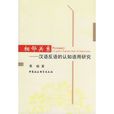《相鄰關係:漢語反語的認知語用研究》是2009年3月1日中國社會科學出版社出版的圖書,作者是黃緬。本書一本關於反語的認知語用研究的專著。
基本介紹
- 書名:相鄰關係:漢語反語的認知語用研究
- 頁數:265頁
- 出版社:中國社會科學出版社
- 出版時間:2009年3月1日
圖書信息,作者簡介,內容簡介,目錄,
圖書信息
出版社: 中國社會科學出版社; 第1版 (2009年3月1日)
平裝: 265頁
正文語種: 英語
開本: 32
ISBN: 9787500477037
條形碼: 9787500477037
尺寸: 20.4 x 14.2 x 1.6 cm
重量: 340 g
作者簡介
黃緬,女,重慶人。2008年畢業於廣東外語外貿大學,獲博士學位,並以優異的成績和出色的研究成果,獲廣東省南粵優秀研究生稱號。現任重慶工商大學外語學院副教授、研究所語言與教學小組組長,有紮實的理論基礎和豐富的教學經驗,曾應邀赴澳門大學和英國布萊頓大學參加國際學術會議並發言。參與主持了省部級、校級科研課題6項,撰寫論文並在外語類學科級、核心刊物上發表論文9篇。
內容簡介
《相鄰關係:漢語反語的認知語用研究》是作者在系統地回顧了國內外相關研究後,意圖建立一個描述反語使用認知過程的語用—認知模型,即“基於心理模型的反語工作機制”,並重點介紹了該模型中相鄰關係的關鍵性作用。全書共有7章,內容豐富,可供理論研究及教學、翻譯實踐等參考使用。
目錄
概術
List of Figures
Chapter 1 Introduction
1.1Preliminary remarks
1.2 The commitment of the study
1.3 The story of irony
1.3.1 Origin
1.3.2 Irony in Chinese context
1.3.3 Classification
1.3.4 Uses and functions
1.3.5 Summary of the section
1.4 Scope of the study
1.5 Methodological issues
1.5.1Lead-in remarks
1.5.2 Research phases
1.6 Data
1.7 Structure of the dissertation
1.8 Summary
Chapter 2 Literature Review
2.1 Introduction
2.2 Historical survey
2.2.1 Greek
2.2.2 Latins
2.2.3 Mediaeval and Renaissance
2.2.4 Early modern times
2.2.5 Modern times
2.2.6 Brief summary
2.3 Theoretical survey abroad
2.3.1 Initial remarks
2.3.2 Non-cognitive-pragmatic studies
2.3.3 Cognitive-pragmatic studies
2.3.4 Summary
2.4 Research in Chinese context
2.4.1 Preliminaries
2.4.2 Chronological survey
2.5 Remaining crucial problem
2.6 Summary
Chapter 3 Theoretical Framework
3.1 Preliminaries
3.2 Methodological constraints
3.3 Theoretical background of the present study
3.3.1 Main assumptions of cognitive linguistics
3.3.2 A brief survey of cognitive pragmatics
3.3.3 Theories of human cognitive abilities
3.4 Towards a unified theoretical framework
3.4.1 MM-based pragmatic reasoning
3.4.2 Explicit expression-implicit expression inference
3.4.3 Autonomy-dependence alignment
3.5 Summary
Chapter 4 Issues of Definition and Taxonomy
Chapter 5 Irony as a cognitive-pragmatic
Chapter 6 Mechanism of the Use of irony Redescribed
Chapter 7 Conclusion
Dictionaries and Encyclopedias Referred
Bibliography
Index
後記

